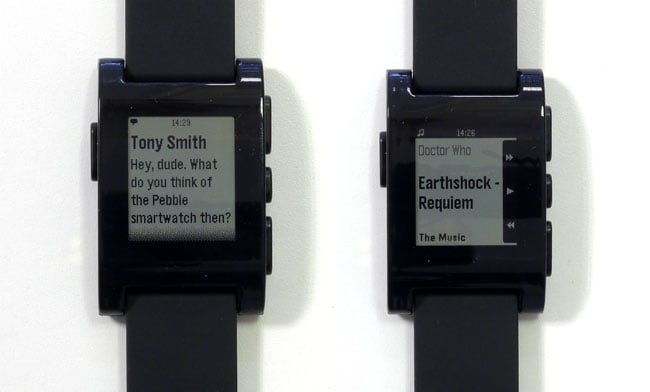This article is more than 1 year old
Q: What's black and white and read all over? A: E-reader displays
Evolving e-books and the holy grail of colour e-paper
Thanks for the memories
Memory LCD – the ones in Pebble are from Sharp – is a type of LCD that incorporates embedded memory, which is used to allow each pixel to hold its state. Unlike E Ink, where power is only needed to change the display, Memory LCD does need a constant supply, but at a very low level. Add a reflective background to the LCD, and you have something that looks uncannily like E Ink, but with the added advantages of faster refresh rates and none of that annoying black flashing.

Often mistaken for E Ink, Pebble actually uses Memory LCD
Set against that, of course, is the need for power. The size of the display in a watch means that you can still manage decent battery life or, at least, rather more than with most other display techs. The new Pebble Time, with its colour display, is also a Memory LCD, this time from Japan Display Inc. Like a traditional LCD, these are based on RGB pixels, so should be able to produce a fairly wide range of colours. However, the lack of backlighting means you'll inevitably have less of a punchy look with this display.
Pass the (paper) parcel
There's another technology that's been promising colour e-paper for a while now too, called electrowetting. This uses an electrical charge to control the surface tension of a small amount of liquid. This allows it to be contracted into a ball, or allowed to flow more freely over the surface of a small container.
If that container's an individually addressable square and the combination of reflective background and coloured fluid is chosen well, you have a pixel that can be turned on or off. For example, use a black liquid, and a white reflective background, and by manipulating the surface tension of the liquid, you can choose whether the pixel appears black or white. Add coloured filter overlays, and you can create a matrix of RGB sub-pixels to build up a colour display. Or double layers and a filter can be used to create CMYK-based displays.
Liquavista's been coming soon for a while now
Liquavista is now an Amazon company, having been spun out of Philips, then sold to Samsung, who eventually passed it on after deciding that they didn't really want it.
The claims for their electrowetting technology are impressive – fast, no need for polarising filters and low power consumption. It can be built using similar technology to a standard LCD, used for flexible displays, and is suitable for the sort of reflective display used in e-paper, as well as transmissive displays such as laptops.
Presumably Amazon likes the technology so much they bought the company with the intention of using it in a future colour Kindle: there are video demos of test devices using it. But so far – just like Mirasol – you'll look in vain for a real, shipping product. All Amazon would say is “it's still early days, but we're excited about the possibilities and we look forward to working with Liquavista to develop these displays”.
